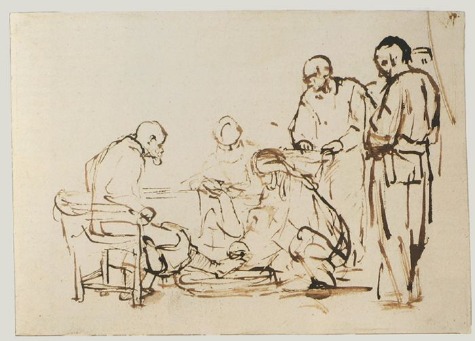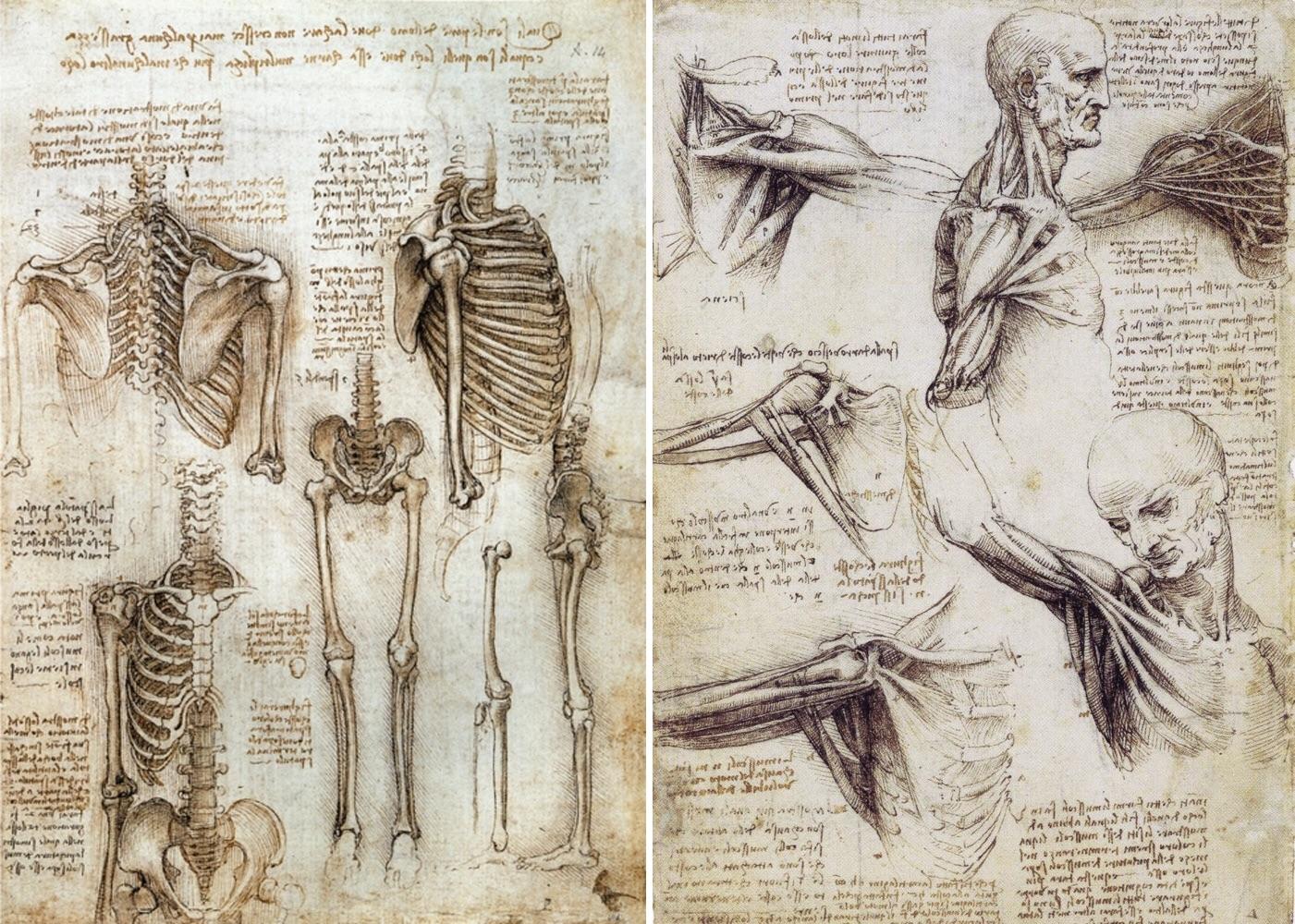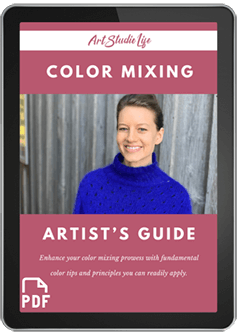Écorché drawing is a drawing (or sculpture) of a human or animal that shows the figure with the skin stripped off – revealing just the muscles and anatomy underneath. In French, the word écorché literally means ‘flayed figure’. Whenever you see a figure with just muscles it is an écorché figure. Écorché is central in the study of anatomy for artists.
Studying these ‘muscle figures’ allows students to study the figure in a highly effective manner. The figure is a highly complex form. So, stripping the figure down to show just the muscles is very helpful when it comes to the study of anatomy.
For example, understanding why an arm has the shape it does because of the muscles underneath helps the artist to paint it convincingly.
Leonardo Da Vinci and Anatomy
The act of studying skinless cadavers goes all the way back to Leonardo da Vinci. Apologies if you are a little squeamish! The main subject of art in the late Middle Ages and Renaissance was the human figure. Thus, this intense interest in the figure led to investigations into how to make the most realistic depictions. Leonardo da Vinci immersed himself into the study of human anatomy – even performing illegal dissections. Surface anatomy was made a fixed part of artists’ training soon after Leonardo’s death. Apprentices were required to create sketches of flayed human figures (écorchés). Leonardo was obviously the forerunner in this field.
Da Vinci left a note on his drawing (below) of a cervical vertebrae that emphasizes the importance of the study of human anatomy: “This illustration is as important for good draughtsmen as the derivation of Latin words for grammarians, since he who does not know which muscles cause what movements will draw the muscles of figures in motion and action in a poor fashion.”
Get some more insights from Leonardo Da Vinci with some of his lessons on drawing.

Importance of Anatomy for Artists
The study of Anatomy is hugely important for all Artists – especially if interested in the figure. When you understand how the body moves and functions, you are able to design and draw the figure without reference. It helps you to be able to draw the body to feel natural and alive. With knowledge of anatomy you are able to sketch and try out different figure designs and play with different compositions. Rembrandt, Leonardo da Vinci, Michelangelo were all able to do this as they had an intimate knowledge of human anatomy.

How to study Anatomy
So, as an artist, you do not need to study anatomy in as much depth as a doctor would need to as you are only concerned with the visible details of it. You do not need to study deep muscle structures that do not affect surface forms unless you are perhaps wanting to draw a zombie…
However, it is also not enough to just study the front, side and back forms of the figure. You need to really understand the function of the muscles so that you will be able to draw the figure in any kind of motion you can imagine. Thus, you need to have a 3 dimensional understanding of anatomy.
The bones and muscles of the human body make up a very complex system. A small change can affect the entire equilibrium of the body.
Where to Start – The Skeleton
It is best to start at a bare bones beginning – no pun intended. The skeleton is the base of the figure on which muscles are draped over. Studying the skeleton first allows you to understand the basic structure of the body and how it moves and maintains equilibrium (balance). You will want to be able to understand the 3d form of the skeleton. Bring yourself to a place where you can recreate the skeleton in any form you wish. When sketching out different skeletons in different positions you will not need to draw out every single bone. Rather, focus on the most important ones that directly affect the form of your figure.
Muscles and Movement
Once you have the skeletal form mastered and have a 3d understanding of it you can move onto muscles. Study how the form of the muscle changes as the figure moves. Do an in depth study of each superficial muscle so that you will be able to visualize what the figure looks like in different positions. You want to be able to create your own figures without using a reference.
For example, if you are wanting to be able to draw your figure throwing a baseball – you will be able to imagine exactly in what position the arms and legs are in as well as the form the muscles have.
Where To Learn More
In order to truly learn how to draw the figure you must immerse yourself in it and spend a great deal of time drawing and studying. There are many anatomy resources available for artists that can help you to learn all that you need to know to mastering the art of figure drawing/ painting. Below are a few that I recommend:
Classic Human Anatomy
This is a classic anatomy book for artists (hence the title!). The book brings a simple yet insightful approach to the figure. It breaks down the complexity of the human form in a tangible way so that the student artist can easily start to grasp how to draw the human form.
Figure Drawing For All It’s Worth
Here is a classic that will make you feel like you transported yourself back to the 40’s. This volume is different than the one above in that the author was an illustrator and takes an illustrative approach to anatomy. However, this book is chock full of information essential for the artist. If you follow the book and do the exercises you will be well on your way to drawing the figure.
Anatomy For The Artist
This book came highly recommended by my painting professor. It has stayed on my bookshelf ever since! An excellent reference volume for all artists.







